viernes, 26 de octubre de 2012
The Cultural Revolution
Read about protests against Vietnam War.
Read about French May.
Read about The Cultural Revolution
By Jungblut & Cardozo
On the Road… with the British Library

A new exhibition started at the British Library honouring a celebrated work by one of the finest authors of the ‘Beat Generation’, Jack Kerouac.
On the Road was written by Kerouac over a hectic three-week period in April 1951. Uniquely, Kerouac typed the manuscript on rolls of tracing paper, which he then taped together into a single scroll to avoid replacing paper at the end of the page and interrupting his creative flow.
It is this scroll – which measures an incredible 120 feet! – which will be on display at the British Library for the very first time in this country between October and the end of December.
The Library owns several works by and about Jack Kerouac, including a copy ofOn the Road. You can also find out more about the author, his life and work, and the history of the ‘Beat Generation’ of 1950′s American authors including William Burroughs and Allen Ginsberg, through one of our many literature databases onLibrary Catalogue Plus.
For further information about the exhibition, visit the British Library website here:
Etiquetas:
Beat Generation,
exhibition,
Literature
viernes, 12 de octubre de 2012
jueves, 4 de octubre de 2012
The Berlin Wall, 20 years gone
 |
| This file photo shows a man hammering at the Berlin Wall on Nov. 12, 1989, as the border barrier between East and West Germany was torn down after 28 years. (AP Photo/John Gaps III) # |
This is part of an article of 2009:
 |
| Smoke from fireworks surrounds the Brandenburg Gate quadriga in Berlin at the end of the official ceremony to mark the anniversary of the reunificiation of Germany, on November 9, 2009. (LEON NEAL/AFP/Getty Images) |
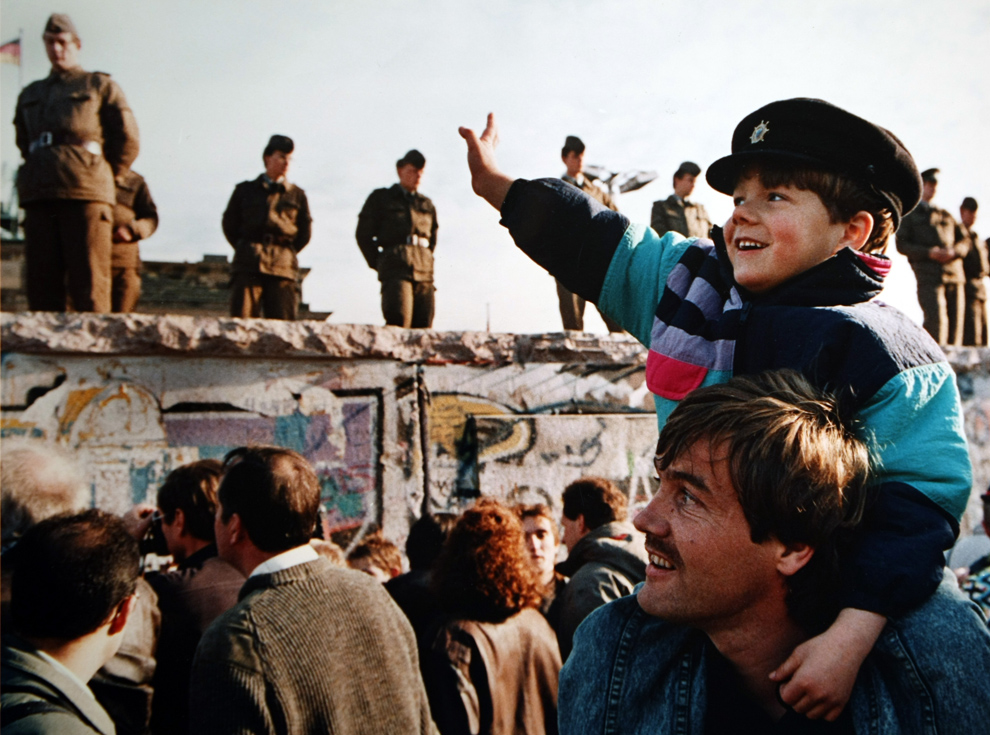 |
| A boy waves to soldiers on the Berlin Wall in front of the Brandenburg Gate on November 10th, 1989. (John Tlumacki/Boston Globe staff) # |
 |
| People stand on a section of the Berlin Wall at Potsdamer Platz. which was opened up on the morning of November 11th, 1989. (John Tlumacki/Boston Globe staff)# |
 |
| East Berliners get helping hands from West Berliners as they climb the Berlin Wall on November 10th, 1989. (AP Photo/Jockel Finck) # |
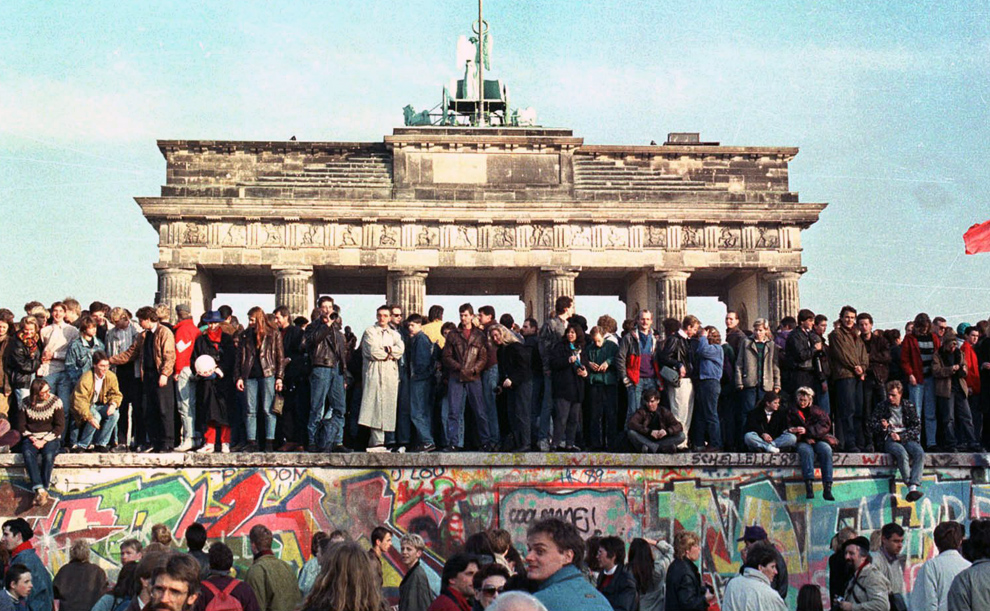 |
| West Berlin citizens continuing their vigil atop the Berlin Wall in front of the Brandenburg Gate on November 10, 1989 file photo (REUTERS/David Brauchli [before]/ |
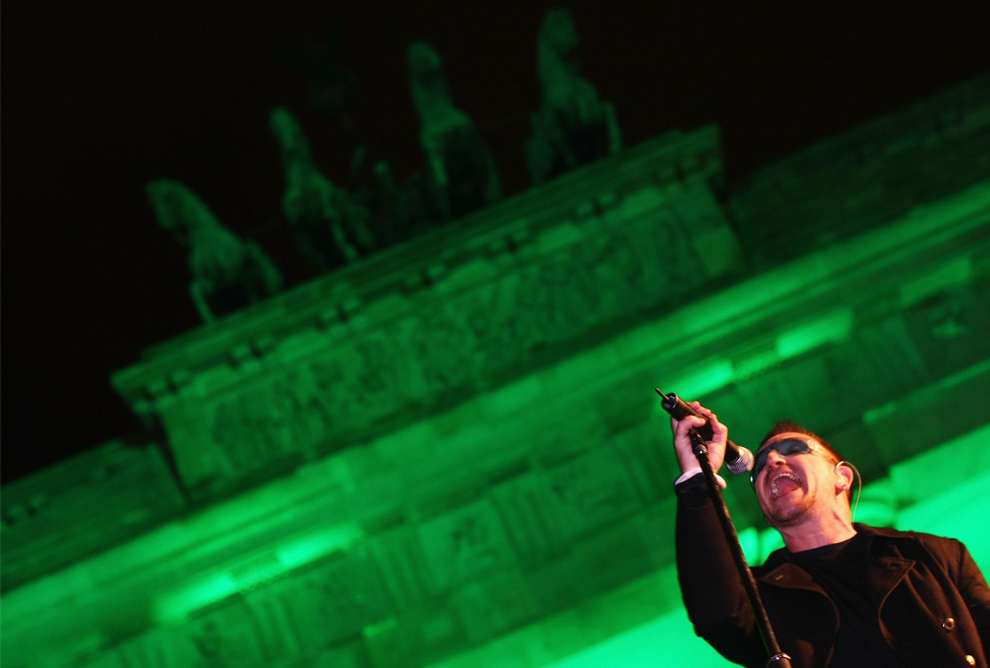 |
| Bono of U2 performs during a concert in front of the Brandenburg Gate the on November 5, 2009 in Berlin, Germany. U2 performed a free concert in collaboration with MTV Europe to help the city celebrate 20 years since the fall of the Berlin Wall. (Sean Gallup/Getty Images) # |
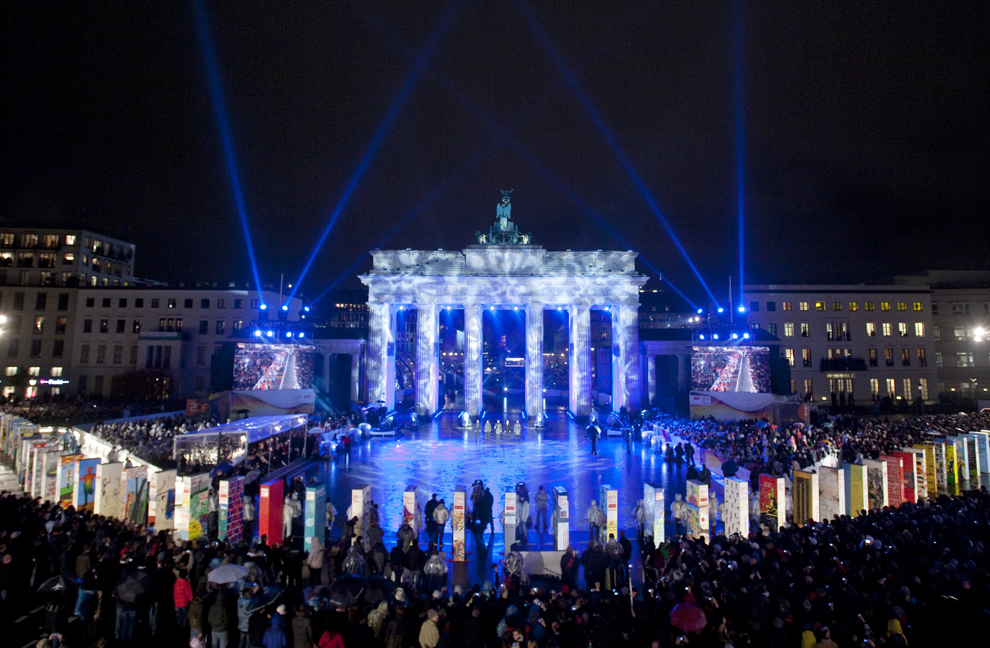 |
| Spectators watch as giant, painted styrofoam dominoes stand along the route of the former Berlin Wall near the Brandenburg Gate on November 9, 2009 in Berlin, Germany. The approximately 1,000 dominoes, painted by schoolchildren and artists all over the world, are meant to symbolically represent the end of communist rule across Eastern Europe and are the highlight of celebrations in the German capitol marking the 20th anniversary of the fall of the Berlin Wall. (Henning Schacht-Pool/Getty Images) # |
http://www.boston.com
Etiquetas:
Cold War; Berlin Wall; Celebrations
viernes, 28 de septiembre de 2012
The Cold War
More on Cold War from this blog ,here.
Cold War in Popular culture. Watch this video of the 1989 song "We didn`t start the fire" by Billy Joel and see how many references to this period of history you can find and define.
Now watch this song of 1987 by Australian band INXS called "Guns in the sky",what event/s related to Cold War is the video making reference to? Find evidence in both the lyrics and video images.
You are supposed to make comments in the ecaths forum.
Etiquetas:
Cold War,
Cold War; Berlin Wall; Celebrations
lunes, 10 de septiembre de 2012
The Return of Pop Art
Campbell’s Releases Warhol-Inspired Soup Cans

In honor of one of their biggest fans, Campbell’s will release their tomato soup with Andy Warhol-inspired designs. The cans celebrate the fiftieth anniversary of Warhol’s pop art masterpiece, “32 Campbell’s Soup Cans.”
“I used to have the same lunch every day for twenty years,” Warhol had famously said of Campbell’s soup. The company sent him cases of it, knowing how much he loved the brand.
The Warhol-inspired tomato soup will be available at Target locations starting in September. They retail for $.75 per 10.5 oz can.
The Campbell’s Facebook page is giving fans a chance to turn their portraits into pop art.
“In the future, everybody will be world-famous for 15 minutes,” Warhol said, and now a few soup fans can get their “15 minutes.” A few users’ photos will be selected and featured on the company’s Facebook page.
More on Andy Warhol and Pop Art in this blog.
http://lenguaycultura2isfd97.blogspot.com.ar/2011/10/pop-art-opt-art.html
http://abcnews.go.com
More on Andy Warhol and Pop Art in this blog.
http://lenguaycultura2isfd97.blogspot.com.ar/2011/10/pop-art-opt-art.html
http://abcnews.go.com
viernes, 6 de julio de 2012
martes, 3 de julio de 2012
Surrealism
Click here to get the PPP on Surrealism by Jungblut and Cardozo. You will find more information in the e-caths blog.
Etiquetas:
20 century,
Art,
Lengua y Cultura 2,
Surrealism
sábado, 30 de junio de 2012
"Berenice Bobs Her Hair" by F Scott Fitzgerald

Reading assignment for the winter holidays ."Berenice Bobs Her Hair" by F Scott Fitzgerald (complete text in e-caths) Movie watching assignment : "The Great Gatsby" based on the novel by F. Scott Fitzgerald. Read complement material on the Jazz Age , in our blog`s past posts.

Bernice Bobs Her Hair" was Fitzgerald's fourth Saturday Evening Post story (1 May 1920) and provided the subject for the dust-jacket illustration when it was collected in Flappers and Philosophers. It occupies an important position in the Fitzgerald canon as a witty early treatment of a characteristic subject that he would later examine more seriously: the competition for social success and the determination with which his characters-- especially the young women--engage in it. The story was based on a detailed memo Fitzgerald wrote to his younger sister, Annabel, advising her how to achieve popularity with boys: "Cultivate deliberate physical grace." Fitzgerald had some difficulty bringing "Bernice" to salable form; he cut some three thousand words and rewrote to "inject a snappy climax. "
www.sc.edu/fitzgerald/bernice/
Work, work and more work!!!

Unbelievably, we are already finishing the first semester of 2012. Before the winter holidays there are some topics we need to work on. First, the Partition of Ireland: sources BBC History ,our blog`s past posts.
In our e-caths blog there are examples of Response essays.
miércoles, 27 de junio de 2012
Cubism
CUBISM
Cubism is 20th century avant garde art movement that revolutonized European art. Until the first decade of 20th century, art, was essentially pictorial and was based on themes of real world ideas, with the emergence of a new "modernist" thinking and an increasing use of machines in industry and daily life, artists sought new ways to interpret the changes taking place around the world. Modern concepts of art were born in Europe. Modern artists reacted abandoning intellect for intuition and depicting the world as they percieved it, they rejected the old victorian standars of how art should be made. Cubism emplied a rupture with the classical aesthetic and a new way to see works of art with the eyes of the mind. The viewer is obligaged to move his eyes to reasemble the picture. Cubism is one of the most influential art styles and it was pioneered by Pablo Picasso and George Braque in Paris , 1907. Its main characteristics are the use of geometric forms, mostly cilinders, cones, spheres and cubes. Artists reduced and fractured the objects into geometric forms and then reasembled them to show several views of objects simultaneously.
In 1914, the start of the world war I wiped out a generation of young artists. After the war, many cubist artists continued developing this style at the U.S.A. where modern art became popular as in the case of collage.
In fact the geometric forms gave the name to the movement.
Cubism is not only found in paintings but also in literature , poetry and arquitecture.
The major part of the work has been done between 1907 and 1914 .
Les demoseilles D"avignon is the first cubist work done by P.picasso... ( Although this is a painting about prostitutes in France which caused
surprise was not the sexual subjet. It was the new and revolutionary tecnique).
As the cubist artists rejected the established concept that art should copy nature as well as the traditional tecniques did.
According to critics of art from that time this movement has been divided in two phases:
The first one is called ANALITIC CUBISM where painters reduced and fractured the objects into geometric forms to realined them, so that they could be reassembled in an abstrat form, the predominant colours were the monocromatic of blue, grey, green and brown.
This ANALITIC period lasted up to 1912 when Picasso incorporated everyday materials such as newspaper cuttings, tickets, tobacco wrappers to the paintings , this marked a difference from the previous phase. So this second Phase was known as SINTHETIC CUBISM.
by introducing physicall elements of real life art ,would become more real and simpler.Colour and texture became more relevant and the word Collage gained and space within art.
Although cubist painters intertwined their work with other styles , from time to time they came over to cubism.In 1937 P. Picasso painted El Guernica, which reflects the Spanish civil war in the city of guernica and the total destruction of the same.
In this picture there is no colour at all , just white and black to express the horror, the sadness and the mourning.
It is necessary to mention in the arquitecture field the work done by Le Corbusier and the Curuchet house here in La Plata.
arquitecture characteristics:
spacial ambiguity,transparency and multiplicity. not classical perspective. IT BECAME AN INFLUENTIAL FACTOR FOR MODERN ARQUITECTURE FROM 1912 . IT IS THE LINKING OF BASIC GEOMETRIC FORMS, BEAUTY AND INDUSTRIAL APPLICATION..
In Argentina one of the most well known cubist painter is Emilio Pettoruti who has been highly influenced by their contemporaries.
spacial ambiguity,transparency and multiplicity. not classical perspective. IT BECAME AN INFLUENTIAL FACTOR FOR MODERN ARQUITECTURE FROM 1912 . IT IS THE LINKING OF BASIC GEOMETRIC FORMS, BEAUTY AND INDUSTRIAL APPLICATION..
In Argentina one of the most well known cubist painter is Emilio Pettoruti who has been highly influenced by their contemporaries.
More pictures here.
jueves, 21 de junio de 2012
miércoles, 13 de junio de 2012
Art Nouveau
ART
NOVEAU
It is an
international style of art, architecture and graphic design which was most
popular within the period from 1890 and 1910. the name of “art noveau” is French
for new art, but it is also known as “jugendstil”
in Germany, which is the german for
“youth style”, “secession” in austria-hungary, “floreale”
in Italy and “liberty” in England.
The name of
this movement was taken from an art gallery called “maison de l’art nouveau”
in Paris.Samuel Bing was his owner. He was a German art dealer. This gallery
was famous for featuring exclusively this kind of art, including furniture and
decorative objects.
Art Nouveau
was most popular in europe but its influence was global, frequently influenced by localised tendencies.
One of the
major visual influences on Art Nouveau was the Japanese art that entered the
west after Japan was opened to trade in the 1850's. many westerners were
intrigued by japanese art's decorative qualities and conception of space and
nature.
The
creators of Art Nouveau advocated the end of the distinction between high art
such as painting and minor art such as decoration.
Reactions
to the cold, mechanical landscape of the industrial revolution and the rigid
classical styles embraced by art academies gave birth to the art nouveau
movement.
It came to
break all connections with classical times, it was a complete change in the way of thinking
about art in terms of a new society and new production methods, sicking to
apply art to everyday lifeto make it nicer.
From that time on, art should not overlook everyday objects, an artists
should work on everything from architecture to furniture design, also jewelry,
pottery, metalwok, graphic design, glassware, textiles and sculpture, to add
harmony and beauty to everyday life.
 |
| Gustav Klimt "The Kiss" |
AS REGARDS THE CHARACTERISTICS OF THIS STYLE:
Ø
it
combines organic lines, feminine forms and a general return to nature as the
inspiration for art.
Ø
typical
colourfull flat patterns, -eliminates three-dimension by reducing shading-
Ø
intertwined
organic forms of stems and flowers.
Ø
emphasized
handcrafting instead of industrial manufacturing -the idea of merging art with utilitarian
objects was partially inspired by a reaction to the ugly manufactured goods
that were beginning to dominate daily
life-
Ø
curving
lines
Ø
modern
techniques with new materials such as iron and steel, -symbolic materials of
first industrial revolution- glass, ceramic and concrete.
Ø
principal
subjects are birds, flowers and female shapes-
Ø
artifacts
are beautiful works of art but not necessarily functional
Women
·
women
were often depicted in a highly sexual manner, in confident postures which conveyed
a strong sense of power and independence. Art Nouveau artists were also some of
the first to use sexy women in advertisements for products such as train
tickets, cigarettes and bicycles. Although sexually provocative advertisements
are commonplace today, they were new and fresh in the 19th century.
Architecture
- Art Nouveau
Architects such as Antoni Gaudi, created buildings with ornamental
structural elements, sinuous flowing lines, open floor-plans and
ornamental facades. They frequently used iron, steel, glass, ceramic and
reinforced concrete. They also made use of technological innovations such
as elevators and electric lights.
Sinuous Lines
·
Art
Nouveau took its sinuous lines and curves from the natural world. For many
artists, the use of lines went beyond ornamentation and decoration. They saw
these lines as visual symbols of spiritual energy. This put them in opposition to
a contemporary Aesthetic movement, and academic rigid classical art which
advocated "art for art's sake." The patterns of Art Nouveau lines
took many forms, ranging from the symbolic to the floral and the organic.
MAIN REPRESENTATIVES:
IN BRITAIN
-
Arthur lasenby liberty
-
Charles ashbee
-
Charles rennie mackintosh
IN FRANCE AND BELGIUM
-
Alphonse Mucha
-
Victor Horta
-
Henry Van De Velde
-
Hector Guimard
-
Émile Galle
IN SPAIN
-
Antoni Gaudi
IN AUSTRIA
-
Gustav Klimt
-
Joseph Hoffman
IN GERMANY
-
August Endell
-
Hernann Obrist
 |
| Galería Güemes, Buenos Aires |
In
Argentina, there was a strong predominance of agricultural exportation, being
the importation of manufactured products mainly from europe.
Another
factor which contributed was Buenos Aires strong dependence on french cultural
tendencies.
And then,
of course, the strong immigration produced during this period –final XIX
century to early XX- the immigrant s hadicraft would leave their mark on
architecture, furniture design, decoration and graphic design.
 |
| Galería Güemes, Inside |
We can see
architecture of Art Nouveau for example in “ Galería Güemes” and in “Confiteria
El Molino” in Buenos Aires.
Then in Rosario,
“El Palacio Cabanellas”, “El Club Español”
y el “Edificio Trasatlantica” works
of spanish artist Frances Roca I
Simo
Nowadays it
is considered as an important transition from 19th to 20th century before
“Modernism” and recognised by UNESCO for its significant contributions to
cultural heritage.
Such as
Ccasa Batllo” and “Casa Vicens” of Antoni Gaudi in Barcelona among many others.
Work done by Chazarreta and Krause
Etiquetas:
Art,
Lengua y Cultura 2,
PPP,
World War I;
viernes, 1 de junio de 2012
History of the Avant Garde
In our classes, we are starting to work with the Avant Garde movements corresponding to the first half of the XXth Century. As introduction to the subject, I leave you a funny poster which explains very succinctly the key elements of each movement. Hope you enjoy it!
Picture selected by Blanca Lòpez Cabrera
Picture selected by Blanca Lòpez Cabrera
Etiquetas:
Art,
avant garde,
Comic,
Dadaism,
Expressionism,
History,
Surrealism,
World War I; Cubism
viernes, 25 de mayo de 2012
Argentina & World War I
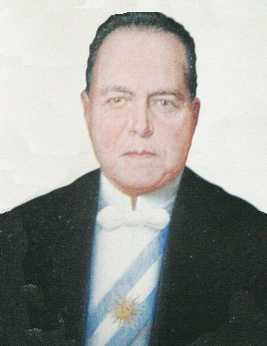 |
| Hipólito Yrigoyen President of Argentina in two opportunities: 1916-1922 and 1928- |
More on Argentina & World War I in our ecaths blog.
|
miércoles, 23 de mayo de 2012
WWI: War in the Trenches
Two views of what life in the trenches was like.One is a video by Sir Paul Mc Cartney and the other the trailer of Spielbierg`s film, War Horse.
See this blog entry from last year related to the subject: http://lenguaycultura2isfd97.blogspot.com.ar/2011/05/world-war-i-and-art.html
See this blog entry from last year related to the subject: http://lenguaycultura2isfd97.blogspot.com.ar/2011/05/world-war-i-and-art.html
viernes, 11 de mayo de 2012
The British by Benjamin Zephaniah
Poet Benjamin Zephaniah joins sixth form students from Lincolnshire and Cambridgeshire to recite his poem The British in a restaurant in Spalding
http://ww.bbc.co.uk
The British
Take some Picts, Celts and Silures
And let them settle,
Then overrun them with Roman conquerors.
Remove the Romans after approximately 400 years
Add lots of Norman French to some
Angles, Saxons, Jutes and Vikings, then stir vigorously.
Mix some hot Chileans, cool Jamaicans, Dominicans,
Trinidadians and Bajans with some Ethiopians, Chinese,
Vietnamese and Sudanese.
Then take a blend of Somalians, Sri Lankans, Nigerians
And Pakistanis,
Combine with some Guyanese
And turn up the heat.
Sprinkle some fresh Indians, Malaysians, Bosnians,
Iraqis and Bangladeshis together with some
Afghans, Spanish, Turkish, Kurdish, Japanese
And Palestinians
Then add to the melting pot.
Leave the ingredients to simmer.
As they mix and blend allow their languages to flourish
Binding them together with English.
Allow time to be cool.
Add some unity, understanding, and respect for the future,
Serve with justice
And enjoy.
Note: All the ingredients are equally important. Treating one ingredient better than another will leave a bitter unpleasant taste.
Warning: An unequal spread of justice will damage the people and cause pain. Give justice and equality to all.
And let them settle,
Then overrun them with Roman conquerors.
Remove the Romans after approximately 400 years
Add lots of Norman French to some
Angles, Saxons, Jutes and Vikings, then stir vigorously.
Mix some hot Chileans, cool Jamaicans, Dominicans,
Trinidadians and Bajans with some Ethiopians, Chinese,
Vietnamese and Sudanese.
Then take a blend of Somalians, Sri Lankans, Nigerians
And Pakistanis,
Combine with some Guyanese
And turn up the heat.
Sprinkle some fresh Indians, Malaysians, Bosnians,
Iraqis and Bangladeshis together with some
Afghans, Spanish, Turkish, Kurdish, Japanese
And Palestinians
Then add to the melting pot.
Leave the ingredients to simmer.
As they mix and blend allow their languages to flourish
Binding them together with English.
Allow time to be cool.
Add some unity, understanding, and respect for the future,
Serve with justice
And enjoy.
Note: All the ingredients are equally important. Treating one ingredient better than another will leave a bitter unpleasant taste.
Warning: An unequal spread of justice will damage the people and cause pain. Give justice and equality to all.
Benjamin Zephaniah
Check ecaths blog for the instructions on the assignment you have to do.
Etiquetas:
Lengua y Cultura 2,
Literature,
poetry
martes, 8 de mayo de 2012
Welcome Emma!!!
Emma Greaves is a young University student from England. She`s Language Assistant with the British Council and will be working in La Plata for four months. She has visited our class and has introduced us to her country and the cultural diversity that means being British in the 21st century. This is the second time a Language Assistant works in our Institute and it`s a pleasure to share knowledge, culture and friendship with them. (Alice Roughton visited us two years ago).
It is also good to remember, as Emma pointed us, that the British Council programme for "Asistentes de Idioma" is also available for Argentinian students to work in the UK. If you want more information, click here.
Emma will be working with us for the rest of her stay and we hope that many classes benefit from her warmth, knowledge and understanding. Besides , her accent is extremely clear for all!!! Thanks, Emma!!!
Log into our ecaths blog and find more about her class.
Etiquetas:
British Council,
Culture,
First hand evidence,
interculturalism,
Lengua y Cultura 2,
UK
lunes, 30 de abril de 2012

In our E-caths blog, you´ll find the texts on Interculturalism in the classroom and Some concepts...
Etiquetas:
interculturalism,
Lengua y Cultura 2,
multiculturalism
martes, 10 de abril de 2012
Pop and Mass Culture
These are the links to the PPP about Popular and Mass Culture we dealt with in class.
https://docs.google.com/presentation/d/129Ja-UXcF5sEql5bFYZHEw9YIiocVqdOcFxK77fIPbU/edit
https://docs.google.com/presentation/d/1BnO_5sLQ50MXtNWTV5ZoTh92pStUzME-8_EqfJyD3hE/edit
https://docs.google.com/presentation/d/12FMtvTj8LpVKxDLibrrB6vh4Nw2CpjYR6BT7uVCW5dA/edit
https://docs.google.com/presentation/d/129Ja-UXcF5sEql5bFYZHEw9YIiocVqdOcFxK77fIPbU/edit
https://docs.google.com/presentation/d/1BnO_5sLQ50MXtNWTV5ZoTh92pStUzME-8_EqfJyD3hE/edit
https://docs.google.com/presentation/d/12FMtvTj8LpVKxDLibrrB6vh4Nw2CpjYR6BT7uVCW5dA/edit
Etiquetas:
Culture,
Lengua y Cultura 2,
pop,
PPP
sábado, 7 de abril de 2012
Welcome to Language and Culture II!!!
Hiya 2012 students!!! You will soon see that this blog will help you complement, give opinion, share and download material for the subject. So here is my piece of advice: check this blog on a weekly basis.
Here goes a link to this year syllabus:
https://docs.google.com/document/d/1HVeS787et0KSkylu3CSA2eviIese53NBjP-MKMSbZhU/edit
And this is the essay on High, Low and Mass Culture we`ll discuss on the first classes.
https://docs.google.com/document/d/1qovvskzWMA4R4ff-9cSejd72gDMvVjs6O5ckBzKihic/edit
See you next Monday at 5pm!!!
Here goes a link to this year syllabus:
https://docs.google.com/document/d/1HVeS787et0KSkylu3CSA2eviIese53NBjP-MKMSbZhU/edit
And this is the essay on High, Low and Mass Culture we`ll discuss on the first classes.
https://docs.google.com/document/d/1qovvskzWMA4R4ff-9cSejd72gDMvVjs6O5ckBzKihic/edit
See you next Monday at 5pm!!!
lunes, 27 de febrero de 2012
Feliz comienzo!!!
Para festejar el comienzo de clases, algo de Arte y Cultura...
Una maravilla (el cuadro de Van Gogh y la animación)
A disfrutar...
Starry Night (interactive animation) from Petros Vrellis on Vimeo.
Una maravilla (el cuadro de Van Gogh y la animación)
A disfrutar...
Starry Night (interactive animation) from Petros Vrellis on Vimeo.
Suscribirse a:
Entradas (Atom)








